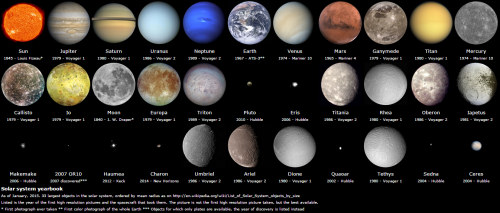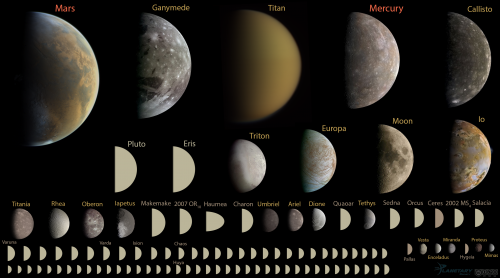The solar system's 'yearbook' is about to get filled in

Lined up like familiar faces in your high school yearbook, here are images of the 33 largest objects in the Solar System, ordered in size by mean radius. Engineer Radu Stoicescu put this great graphic together, using the highest resolution images available for each body. Nine of these objects have not yet been visited by a spacecraft. Later this year, we'll visit three of them and be able to add better images of Ceres, Pluto and Charon. It might be a while until the remaining six get closeups.
"This summer, for the first time since 1989," Stoicescu noted on reddit, "we will add 3 high resolution pictures to this collection, then, for the rest of our lives, we are not going to see anything larger than 400 km in high definition for the first time. It is sad and exciting at the same time."
Dawn will enter orbit at Ceres approximately March 6, 2015, four months before New Horizons flies past Pluto and Charon.
But a comprehensive Solar System yearbook might never be completed. Not only will there likely be new dwarf planets discovered in the Kuiper Belt, uUnless things change in the budgetary and planetary missions departments for any of the world's space agencies, the remaining six unvisited objects in the graphic above will likely remain as "fuzzy dots" for the rest of our lives.
For more Solar System yearbook-like imagery, Emily Lakdawalla has also created some wonderful graphics/montages of our Solar System, like this one:

As Emily wrote in the accompanying blog post, "Just look at all of these worlds, and think about how much of the solar system we have yet to explore. Think about how much we have to learn by orbiting, and maybe even landing on, those planet-sized moons. Think about how Pluto isn't the end of the planets, it's the start of a whole new part of the solar system that we've never seen before, and how seeing Charon is going to clue us in to what's happening on a dozen other similar-sized, unvisitably far worlds."
More information: If you like the graphic above, you can see more imagery and space discussions: www.reddit.com/user/Tanchistu
Source: Universe Today





















